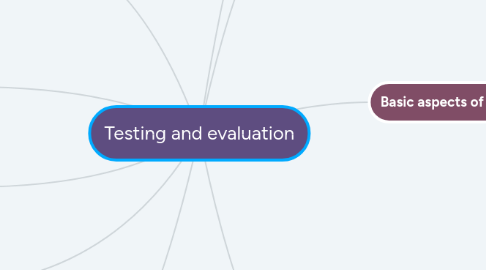
1. Balancing validity and reliability
1.1. A valid test for a course with communicative objectives should include excercises and tasks in wich the learners use language in realistic contexts. For example, they could complete a dialogue, write a letter, and role-play an interview. These tasks would test their ability to use specific gramar and vocabulary, to use written English effectively, and to understand and produce effective spoken English
2. Writing and evaluating achievement tests
3. Test excercises and tasks
3.1. Greater realibility Greater validity Objectivity --------------------- Subjectivity Language ------------------ Communication Recognition -------------------- Production
4. Improving tests
4.1. Is extremely difficult to write good original tests. In fact, it is difficult and time-consuming even to write bad ones! For this reason it is usually better not to write new tests every time you need one.
5. Evaluating learning, teaching, and courses
5.1. Evaluating learning: Although they are useful, tests are only one way of evaluating. It is important to remember that you can also note how effectively the learners communicate in free conversation and groupwork, how well they use the language in homework compositions, and even ask them for their own impression of their progress.
5.2. Evaluating teaching: Learners’ test results are one way to evaluate teaching.
5.3. Evaluating courses: Courses can be evaluatd by using learners’ test results, questionnaires given to learners and teachers, and class observation.
6. Teaching and testing
6.1. The teacher is responding only to the language of learners’ replies, not the information
7. Testing and evaluation
7.1. Evaluation is more general concept than testing. You can evaluate teaching, teaching materials, and even tests, as well as learning. Also, learning can be evaluated in several different way, not only only with the format tests that you give the learners.
8. Basic aspects of testing:
8.1. Types of test
8.1.1. Placement test: To place of new students in the appropiate course or level. These are essential in large institutions that frequently receive new students
8.1.2. Diagnostic test: To find out learners’ stregths and weaknesses are the start of a course. They allow the teacher to adjust his or her teaching to the needs of the group and individual learners. They are especially useful with mixed-level groups.
8.1.3. Progress test (Short-term achievement tests): To check how well learners are doing after each lesson or unit, and provide consolidation or remedial work if necessary. They usually focus on language that has recently been introduced and practised.
8.1.4. Course tests (Longer-term achievement tests): To check how well learners have done over a whole course. These are the commonest basis for the marks teachers give learners at the end of each course.
8.1.5. Proficiency tests: To determine learners’ levels in relation to generally accepted standards. These useful for the objective evaluation of learning, and also for the indirect evaluation of learning, and also for the indirect evaluation of course design and teaching. The two best known systems of international proficiency tests are the UCLES exams and the TOEFL tests.
9. Validity and reliability
9.1. An achievement test can be considered to have validity if
9.1.1. It contains only forms and uses the learners have practised in the course
9.1.1.1. The firts type of validity, called content validity, means that the gramar, vocabulary, and functional content of a test should be carefully selected on the basis of the course syllabus.
9.1.2. It employs only excercises and tasks that correspond to the general objective and methodology of the course.
9.1.2.1. The second type of validity, called construct validity, means that the excercises and tasks in a test should be similar to those used in the course and correspond to the general approach of the course.
